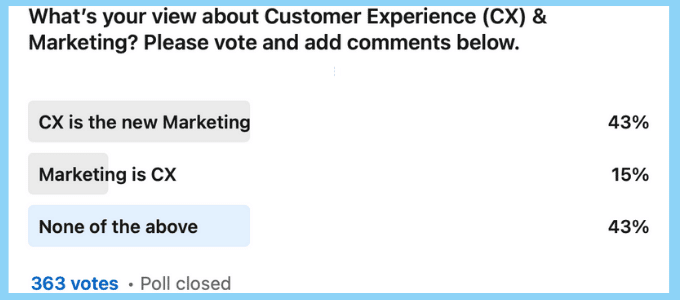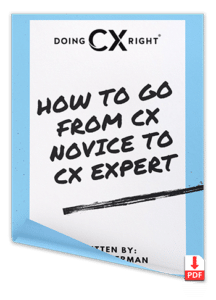Getting Executive buy-in and budget for customer experience programs is not so easy when there are leaders at the top who don’t fully understand the true value of CX. MyCustomer interviewed me and other customer experience professionals to find out what we have learned and recommend to gain resources and investments to support CX goals. I’m sharing a copy of the original article in hopes that more people will learn and apply the key tactics shared.
How To Get Customer Experience Investment
As we discovered in a previous article, a combination of factors has conspired to make the job of demonstrating the value of CX programs more important than ever for customer experience professionals.
Whether it be the difficult trading conditions creating a squeeze on resources and budgets, or the concept of customer experience management becoming less seductive to the c-suite, or even the CX profession finding itself distracted by the trivial instead of the operational, boardrooms are less willing to support CX programs unless they are convinced by their ROI.
We spoke to a cohort of customer experience professionals to find out what they have learned about demonstrating CX value to company leadership during their careers so that we can glean insights into how to win hearts and minds in the c-suite.
But be warned – some bosses are easier to convince than others. As Stacy Sherman, Director of Customer Experience & Employee Engagement at Schindler Elevator Corporation, notes: “Not all leaders understand the importance of investing in customer experience resources, tools, and platforms. That’s because measuring culture, employee engagement, customer loyalty, and related KPIs are not as easy as counting eCommerce sales or retail transactions!”
For these CX skeptics, it can be necessary to build confidence and trust through an incremental approach. Iain O’Connor, senior manager for customer experience and insight at Aegon UK notes: “It’s important to build trust and belief amongst senior leadership and depending on your starting point that may mean starting small with quick wins to show what can be achieved and the impact CX improvements can have on customers but also on internal engagement and culture.”
Sherman agrees: “I recommend you gain buy-in through pilot programs and show impacts in small ways (quantitatively and qualitatively) to then ultimately grow and scale your customer experience programs.”
The power of storytelling
Nina Jones, head of advisor experience at Fidelity International, is another advocate of using qualitative and quantitative demonstrations to generate confidence in customer experience programs. “From my perspective, it is a combination of both qualitative and quantitative data which a customer experience team needs to have to be successful with senior leaders,” she explains. “It is a pure classic play to convince both the right and left-brain people… there are those senior executives who will gladly come with me on an emotional journey if I tell them a really good story; there are others who are only interested in hearing the whole story if it is based in cold, hard facts!”
Nina continues: “Looking back, most of my career has been in engineering-centric organizations, so this led me to always have my data and metrics available and known, as the culture within engineering organizations is naturally data-centric. Whichever job I am in, I always need to have a data analyst or data insight team close to me, so that I am able to prove or disprove my own theories before I even think about stepping into a board room to present a case.
“However, I have also realized that even the most hardened CEOs also love a good story, as they are, at the end of the day human beings! So, by making sure I have all of the compelling data and metrics, the key is then to play it into a compelling story where a CEO or the c-suite are able to rationally and emotionally engage with the experience that the investment is going to make better.”
Keith Gait, leader at The Customer Experience Foundation, and former customer services director at Stagecoach Bus, believes that storytelling allows customer experience managers to bring data alive and show a journey.
“Bring the issues to life with real life examples of failings within the business that hit hard,” he advises. “In my last organization I showed a 15-year-old boy being verbally abused and then put at risk by an employee to demonstrate the issues with front line culture and management behaviors that had been recorded by a member of the public. These are difficult to argue with. Share verbatims. Then demonstrate the financial impact this has on the business. At one company I worked with, we were able to show that every 1% of churn affected revenue by £10milllion, and that churn was directly caused by CSAT.
“Then show the journey of how you go from the baseline to the improvement outcome, whatever that may be, and the staging posts along the way. The key here is to try and show the metrics that will be tracked. It’s not always easy to show direct financial improvement, but we can show many proxy measures that we know will increase the bottom line.”
Customer feedback
Charlotte Dunsterville, chief consumer officer at Sure, is in regular contact with the c-suite to discuss customer experience opportunities and challenges. And to maintain buy-in and foster enthusiasm in ongoing CX investment, she ensures that leadership is privy to direct customer feedback that is collected.
“We have a comprehensive program of customer insight taking in relational and transactional surveys alongside a really engaged panel of our customers who are keen to give us feedback and get involved in ideas for new product launches, how our customer journeys are working, and input on our customer service,” she explains.
“I regularly present direct customer feedback to the senior team so that senior leaders are aware of the pain points, and we also use an automated platform internally to gather employee feedback and understand what we are getting right and what we could still improve for staff. In fact, we treat the customer and employee feedback very similarly with an ongoing loop of feedback, taking action and checking back in.
The approach I’ve found most useful to justify investment is to make sure that senior leaders are close to the feedback.
“So, in summary, the approach I’ve found most useful to justify investment is to make sure that senior leaders are close to the feedback, understand the pain points, and then it’s actually the c-suite leading the charge to improve the experience rather than it being justified by a specialist team. Win-win!”
Patricia Sanchez Diaz, head of customer experience at Centrica, is another advocate for the combination of data and storytelling as a device to demonstrate value but believes that CX professionals, in general, need to work their data harder through analytics.
“One of the fundamental gaps in CX teams is their ability to link improvements or innovation to business strategic targets and to measure it,” she argues. “CX makes sense if it brings value to the business. Often CX teams go about saying that when you bring value to the customer they return, spend more, and therefore the ROI increases – but that needs to be empirically proven.
“CX teams don’t do analytics in many cases – and that’s a mistake. Storytelling + CX analytics that will be the formula to generate funding.”
Proving ROI in a customer-centric, not company-centric way
In a recent article on MyCustomer, Gartner’s Augie Ray warns that one of the main pitfalls customer experience leaders must avoid when demonstrating CX program ROI, is to focus on monetary returns.
By trying to demonstrate how much money the business is making from CX initiatives, it is adopting a company-centric approach, instead of a customer-centric one, he suggests. CX leaders should be demonstrating what they get by improving customers and their relationship with the brand, rather than probing how much money can be extracted from them or how much costs can be reduced to lift short-term income.
He explains: “CX leaders must answer the ROI question in a way that doesn’t merely turn CX into another strategy for lowering costs or lifting acquisition. Instead, leaders need an approach that demonstrates how the company profits when customer expectations are understood, their needs are met, and their relationships strengthened.”
Ray recommends that the way to keep the focus on the customer while still demonstrating the ROI opportunity to business leaders is to follow three steps:
- Step one: Start with data on customer perception. The starting point is to make sure you have customer-sourced information about customer perception. This is typically derived through Voice of the Customer (VoC) surveys asking questions about customer satisfaction (CSAT), customer effort score (CES), or net promoter score (NPS).
- Step two: Combine and analyze your VoC and operational data. The next step in the process is to find and use operational and financial data at the customer level. Most typically, CX leaders will seek to collect and import data on retention, sales growth, number of products acquired, cost to serve, or referral volume. Once you combine the VoC scores provided by customers and the financial or business data of those same customers, you can begin to analyze the differences in business and financial value associated with customers who are satisfied versus dissatisfied.
- Step three: Get the right data to the right people. Research demonstrates that organizations drive more customer-centric decision-making by showing leaders why being customer-centric is in their own best interest and not merely in the best interests of the entire firm. For example, you might show digital leaders that highly satisfied customers are more likely to trust, adopt and engage with the company’s digital platforms. By analyzing the relationship between customer satisfaction scores and a variety of business metrics, CX leaders can show the ROI of CX in terms of the outcomes for which each leader is responsible.
Ray concludes: “You’ll note that this approach keeps the focus on the customer – their perception and satisfaction with your products and services. We are not merely calculating how much the company can make or save from a given CX effort but instead proving why lifting CSAT, CES, and NPS scores benefit the organization’s growth, margin, and bottom line. By taking this approach, we keep the focus on the customer while demonstrating that customer satisfaction is a business driver worth investment.”
Final advice
But a final word of advice – be prepared for your attempts to demonstrate value go awry. And if your presentation to the board doesn’t go according to plan, don’t give in!
As Nina Jones notes: “Board meetings do not always go as you may have planned even with your most bulletproof business case! However, in my experience ‘no’ doesn’t mean’ no’ most of the time. It usually means, ‘you haven’t convinced me yet’…therefore, from a personal approach perspective, there is a need for customer experience leaders and teams to have bucket loads of tenacity and resilience to be able to dust themselves down, have a good wash up to truly understand what was being said in the room, get back on the horse, regroup and go again!
“Keep the faith that if it is the right thing to do, it may need a couple of goes! I have personally been working on a program for 12 months now with a bulletproof business case and we have still not got everything we need! We will though, I am determined as it is the right thing to do! One thing about a really long protracted decision-making cycle, it provides the opportunity to ensure the business case is, indeed as robust as you think it is!”









